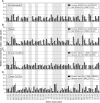Comparative study of synonymous codon usage variations between the nucleocapsid and spike genes of coronavirus, and C-type lectin domain genes of human and mouse
- PMID: 19561398
- PMCID: PMC2772977
- DOI: 10.3858/emm.2009.41.10.081
Comparative study of synonymous codon usage variations between the nucleocapsid and spike genes of coronavirus, and C-type lectin domain genes of human and mouse
Abstract
Coronaviruses (CoVs) are single-stranded RNA viruses which contain the largest RNA genomes, and severe acute respiratory syndrome coronavirus (SARS-CoV), a newly found group 2 CoV, emerged as infectious disease with high mortality rate. In this study, we compared the synonymous codon usage patterns between the nucleocapsid and spike genes of CoVs, and C-type lectin domain (CTLD) genes of human and mouse on the codon basis. Findings indicate that the nucleocapsid genes of CoVs were affected from the synonymous codon usage bias than spike genes, and the CTLDs of human and mouse partially overlapped with the nucleocapsid genes of CoVs. In addition, we observed that CTLDs which showed the similar relative synonymous codon usage (RSCU) patterns with CoVs were commonly derived from the human chromosome 12, and mouse chromosome 6 and 12, suggesting that there might be a specific genomic region or chromosomes which show a more similar synonymous codon usage pattern with viral genes. Our findings contribute to developing the codon-optimization method in DNA vaccines, and further study is needed to determine a specific correlation between the codon usage patterns and the chromosomal locations in higher organisms.
Figures



References
-
- Ahn I, Son HS. Comparative study of the hemagglutinin and neuraminidase genes of influenza A virus H3N2, H9N2, and H5N1 subtypes using bioinformatics techniques. Can J Microbiol. 2007;53:830–839. - PubMed
-
- Bode JG, Ludwig S, Ehrhardt C, Erhardt A, Albercht U, Schaper F, Heinrich PC, Häussinger D. IFN-α antagonistic activity of HCV core protein involves induction of suppressor of cytokine signaling-3. FASEB J. 2003;17:488–490. - PubMed
-
- Cary NC. SAS 9.1.2 Qualification Tolls User's Guide. NC: SAS Institute Inc.; 2004.
Publication types
MeSH terms
Substances
LinkOut - more resources
Full Text Sources
Miscellaneous
